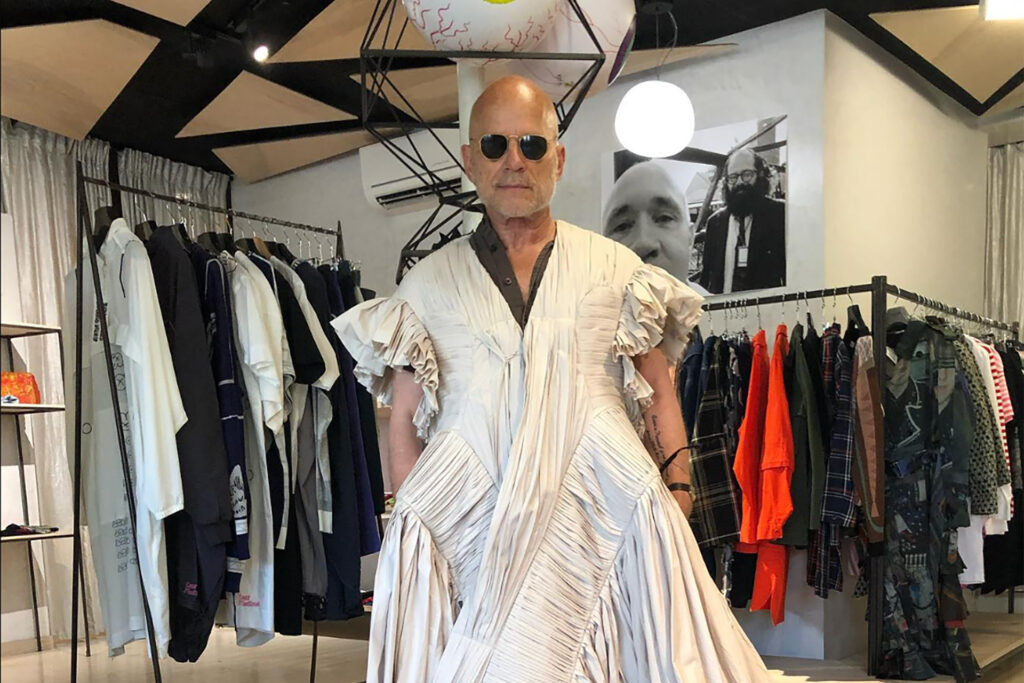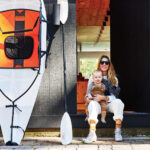As the celebrated writer and editor prepares to leave his adopted home, he walks us down Warren Street, in style.
Pictures and Words by Kevin Sessums
You gotta have style. It helps you get down the stairs. It helps you get up in the morning. It’s a way of life. Without it, you’re nobody. I’m not talking about lots of clothes,” said Diana Vreeland, the legendary French American fashion columnist and magazine editor who never really said anything, come to think of it, but instead issued forth words with that Vreeland vroom of hers—a purr which she utilized to make her pronouncements aimed at grownups who were just a little too grown-up for her taste. She delighted others but found delight to be too off-the-rack for her, so subsume it. She preferred to preen with joy when she was pleased. I like to think of Vreeland as what happened to Eloise when she got too tall—only slightly—to keep that kid act of hers going at The Plaza, so had to reinvent herself as another New York character—but one with the subtle notes of Eloise still intact next to that consideration in her purr. Reinventions tend to work when they remind others of an earlier inventive act of creation without having to resort to a replication of it.
1: Unlike fashion, style is timeless and shape-shifts to fit one’s latest reinvention. Style is not about the fit. Style is instead fitting.
I moved to Hudson almost five years ago from San Francisco after giving that city five years of its own when, needing to reinvent myself after my 38 years in Manhattan, I moved west to create a magazine as its editor-in-chief. I’d never even been to Hudson before that first snowy day in the middle of January, when I arrived here to reinvent myself yet again.
This stylish little town has reinvented itself many times over from its whaling days when guys on those boats up and down the Hudson River dropped anchor here to find out just how libertine they could be. The lore of the place is that it didn’t have a red-light district; back then, the whole town was red-lit. For a time, it was where the mafia set up its own Mayberry. Then the mid-century dealers moved in and it became a design Mecca. It was still Mayberry but one directed by Wes Anderson. Now it’s a kind of Brooklyn North, its sidewalks on Warren Street filled on some days with hip young people and older sophisticates who, when they were an earlier version of such young people, settled into an alchemic style that anchored them in themselves.
“‘Style is the answer to everything,’” designer, painter and jazz lover Marine Penvern told me one afternoon, quoting Charles Bukowski from Track 25 of his Master Collection LP, when she and painter Jeff Sonhouse came over to my loft for a visit. “‘To do a dull thing with style is preferable to doing a dangerous thing without it,’” she said. “’To do a dangerous thing with style is what I call art.’” Marine’s atelier is at 715 Warren Street where, when she’s not reading Bukowski, she can be found working on her creations in the rear sewing room or sitting on a bench out front playing her sax, Coltrane flowing colorfully from her as if she has spun his notes into the silk fabric she uses to make her signature caftans patterned from her abstract paintings.
Marine has an exhibition of her paintings opening in February at Hudson Hall which will consist not only of her abstract works but also portraits of characters around town whose style isn’t only embedded in their faces that Marine has rendered with a tender yet tough-eyed realism, but also in their character. Characters with character is a kind of summing up of those I’ve gotten to know here who no longer have the exhausting need to be fashionable. Because they no longer have that need, the first thing I noticed about them was how more deeply stylish they are. Their style was what led me to want to know them better. Fashionable people are fine but having a deeper sense of style is often the first clue I need to decipher a new friendship. Such deciphering happens a lot for me in Hudson.

2: Style isn’t about money; it’s about being a real-life character. Let the bills become make-believe. Real style states, “I’m paid-in-full.”
The most inexpensive place in town to shop for clothes is Second Show Thrift Store, which benefits Columbia Memorial Hospital and Operation Unite, the latter a collaborative to reduce drug addiction and promote recovery. Judy Engel and I like to shop there and brag to each other that we “got at Second Show” when we wear what we found in its racks which usually elicits a compliment from the other. Not only do we like a bargain, but we more deeply like that buying something that fits our style at a charity thrift store can also be about generosity and an act of service.
Other stores in Hudson I like for their sense of style are Mikel Hunter’s cutting-edge boutique and gallery at 533 Warren which is a kind of twin of his other store on Martha’s Vineyard in Edgartown, one that has the familial aesthetic but needed to make a home of its own to hone it further. Next door to Judy Engel’s midcentury shop is Nikki Chasen’s boutique at 533 Warren where she sells her namesake label of classic but playful designs which she describes as having a “streak of tongue-in-cheek rebelliousness.” We bonded over our love of our pets. She has two dogs, one of them rescued from Mississippi. “Shut yo’mouth,” I said when she told me that. “I’m from Mississippi. I was rescued from there, too.”
Sam Logan owns Meridian at 438 1/2 Warren which he describes on its website as “a digital and physical space for contemporary clothing and visual culture.” I had a crush on him when I first moved here but learned long ago not to pine for straight guys. So now I go in to talk about navigating an exit from his marriage with his purposeful grace (his own mindful brand), parenting his two young sons and who the lucky lady might be he’s dating lately. One of the greatest joys I’ve discovered here is seeing Sam and one of his sons skateboarding together up and down Warren. It takes a lot of style—and even more love—to pull off being a dad who can do that. In fact, the last time I saw them skateboarding toward me when I was walking to the train station, I told his son that he had the coolest dad on the planet. “Do you know that?” I asked as he sped by. “I know that,” he called back to me.
3: Fashion is a sentence you read. Style is a sentence you write.
Having a sense of home within a herd is what being fashionable finally offers, but individuality is the foundation of style. It also has given Hudson its commercial one. Even the furniture stores and boutiques here along Warren’s ten long blocks are defined by their individuality, almost all of them independently owned. An exception is the latest outpost of Westerlind, the outdoor apparel emporium managed by Tom Pawlowski. Its founder, Andrea Westerlind, is mindful about her brand—being mindful about it is, in a way, her brand—so has been careful about her company’s expansion. Its recent footprint in Hudson proved to me that the town’s hipness, always an evanescent concept, has hardened into a fact found now in market research.
Kasuri was once the first boutique you encountered when turning onto Warren Street from the train station. But there was a flood in the building several months ago and it’s still under reconstruction. Kasuri is now located temporarily in The Warehouse, the shop’s haute couture finding itself surprisingly in dialogue with the furniture that mostly competes for the attention of customers in the vastness of the place just as the designers it carries—Vivienne Westwood, Yohji Yamamoto, Rick Owens and Walter Van Beirendonck among them—are in dialogue across generations you begin to discern when you shop at Kasuri because its creative director, Jonathan Osofsky, who grew up on a Columbia County dairy farm, has a taste for narrative threads as well as the luxurious ones used by such designers to manifest the incongruities of punk. “The designers we carry have been profoundly influential on fashion design but they transcend it,” Jonathan said, which sounds like a mission statement for style. “In fact, they really represent a kind of anti-fashion, uninterested in the trend cycles.”
4: One can be mean and still be stylish. But kindness never goes out of style.
Marine is just one of the people with whom I have become friends because they have accessorized their style with kindness. Many, like Marine, own their own stores. Sculptor Judy Engel’s Modern on the Hudson is right across the street from my loft. I often stop in not only to chat and catch up, but also to see what outfit she’s wearing. She curates her clothes with the same keen eye with which she curates her two floors of mid-century furniture and design. We bonded in the pre-pandemic days when we volunteered to help prepare meals for CampHills’ community dinner on Monday nights. She even looks stylish in an apron.
Another couple, Nina Ziefvert and her husband Tshidi Matali are, respectively, from Sweden and Botswana. They own side-by-side vintage stores, Nina Z and Bontleng, at 345 Warren. Their curation isn’t hopelessly hip but somehow gives one the hope of being able somehow to be as hip as they are. Nina even designs her own line of clogs.
I like to shop for vintage clothes and when you do so at Look Apparel and Accessories, the designer vintage boutique in the back of Fresh Stockholm, the cosmetics store at 401 Warren, you can be assured that Marie and Ian—everybody just calls them Marie and Ian—have already sorted out the best recent choices from what they have in storage and from their carefully culled sources. You can trust them about pricing. More important, when you try something on you can trust them to tell you if it makes you look silly or furthers your style which they have instinctively sized up when you walked in. Last Christmas season when I was shopping for a gift there, they instinctively knew I’d be alone on Christmas Eve and invited me to a small dinner at their home because that too is their style.
“The best time to leave a party is when the party’s just beginning,” was another pronouncement issued by Vreeland. “There’s no drink that kills except the drink that you didn’t want to take, as the saying goes, and there’s no hour that kills except the hour you stayed after you wanted to go home.”
I left Hudson at the end of October and headed to London as my new home base for six months a year. I’ll be there until March and then in Paris through April. I haven’t decided about the rest of 2023, but that’s the great thing about the pilgrim’s life I’m about to embark upon: I don’t have to decide yet.
The initial decision to become a pilgrim—I like that term better than elder nomad—was my latest act of reinvention. After five years in Hudson, I don’t think I left the party early. It has instead become a different kind of party. The pandemic changed the place as even more New York City residents sought refuge in Hudson and its surrounding area and discovered that they, too, liked being city refugees in such a small-town, bucolic place where they could also buy the cheese they like and have dinner parties with likeminded folks who find comfort in style as much as the right kind of fromage.
Richard Stengel, the former top editor of Time who served as an Under Secretary of State for President Barack Obama and collaborated with Nelson Mandela on his autobiography, Long Walk To Freedom, has had a home outside Hudson for years. I ran into him the other day having lunch at The Cascades, the cafe on Warren where locals eat, a place that doesn’t worry about the rightness and wrongness of whatever cheese is back in its kitchen.
We talked about his appearances on MSNBC as a talking head, which was a reinvention for him when he first took the job, and my own imminent reinvention as a pilgrim setting off to engage with the world in a different way. I told him I had donated most of my library to Time and Space Ltd. in gratitude for enriching my life while I lived these last few years a few blocks away from it, had re-homed my cats, Finn and Matty, breaking my own heart, and had sold everything I own except for a few pieces of art, my three watches and the clothes that can compose a wardrobe that consists of blacks and grey along with some old white shirts. “After a guy reaches a certain age he should dress like a chic lesbian anyway,” I said with—God help me—a considered purr. “When I go to my closet each morning, I stare at my clothes and ask myself one question: ‘What would Kate Clinton wear?’” I looked over at Rick to inspect his casual lunchtime attire. “You understand. You already dress like a lesbian with style,” I complimented him. But he wasn’t sure if I had. The sweet befuddlement on the face of a man who’s so seldom befuddled unexpectedly moved me.
As I continued my walk home that day to my loft where I was now editing my life after a life lived editing my stories, I added this lovely little lunchtime happenstance to the memories I’ve made here. Where else but Hudson could you run into Richard Stengel and tell him he looked like a well-dressed lesbian? I’m going to miss this place. But it was time to move on. Because that—moving on—is precisely my style.















Comments are closed.